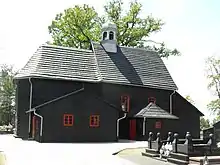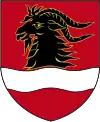Wieruszów
Wieruszów ([vjɛˈruʂuf]; German: Weruschau) is a town with 8,639 inhabitants (2016).[1] Situated in the southwestern part of Łódź Voivodeship (since 1999), From 1975 to 1998, it was part of Kalisz Voivodeship. The town is situated along the Prosna river.
Wieruszów | |
|---|---|
 Pauline Monastery and Church of the Holy Spirit | |
 Flag  Coat of arms | |
 Wieruszów  Wieruszów | |
| Coordinates: 51°18′N 18°9′E | |
| Country | |
| Voivodeship | Łódź |
| County | Wieruszów County |
| Gmina | Gmina Wieruszów |
| Established | before 13th century |
| Town rights | 1297-1870, 1919 |
| Government | |
| • Mayor | Rafał Przybył |
| Area | |
| • Total | 5.98 km2 (2.31 sq mi) |
| Population (2016) | |
| • Total | 8,639 |
| • Density | 1,400/km2 (3,700/sq mi) |
| Time zone | UTC+1 (CET) |
| • Summer (DST) | UTC+2 (CEST) |
| Postal code | 98-400 |
| Area code(s) | +48 62 |
| Car plates | EWE |
| Climate | Cfb |
| Website | http://www.wieruszow.pl |
History

Wieruszów was granted town rights, when it was part of Piast-ruled Poland. The town developed in the Late Middle Ages under the patronage of the Polish noble Wierusz family. It was a private town, administratively located in the Sieradz Voivodeship in the Greater Poland Province of the Polish Crown. The local Catholic parish was erected in 1386 by Przecław of Pogorzela, Bishop of Wrocław.[2] In 1401, Bernard Wierusz founded the Pauline monastery.[2] Augustyn Kordecki, prior of the Jasna Góra Monastery in Częstochowa, commander of the heroic and successful Polish defense of Jasna Góra during the Swedish invasion in 1655, died in the monastery in Wieruszów in 1673.[2] The monastery was rebuilt in its present form in 1676 in Baroque style. The church interior contains nine Baroque altars and choir stalls from 1682. There is a portrait of Bernard Wierusz, the first owner and founder of the church at the choir.
The town was annexed by Prussia in the Second Partition of Poland in 1793, then regained by Poles and included within the newly established, but short-lived, Duchy of Warsaw in 1807, and in 1815 it passed to the Russian Partition of Poland, while its Podzamcze suburb fell again to Prussia, and from 1871 formed part of Germany. As punishment for the unsuccessful Polish January Uprising, Wieruszów was among over 300 towns stripped of their town rights by the Tsarist administration in 1869–1870, and the Pauline monastery was closed down.[2] After World War I, in 1918, Poland regained independence, and Wieruszów was reintegrated with Poland, while Podzamcze was still held by Germany. Town rights were restored. In April 1919, the German artillery fired 18 shells from Podzamcze at a crowd at the town's weekly market, killing seven people, including a 9-year-old boy.[3] From June to August 1919, the Germans repeatedly shelled the town and attempted an invasion, but were repelled by the Poles.[3] Dozens of houses were destroyed.[3] Soon after, as a result of the successful Greater Poland Uprising against Germany, Podzamcze was restored to Poland. A monument to the insurgents was erected in Podzamcze in 1925.[4] Until World War II, the town had a significant Jewish population of more than 2,000.
As a result of the joint German-Soviet invasion of Poland, which started World War II in September 1939, the town was occupied by Germany. The Germans immediately murdered several Poles[5] and Jews and kidnapped others. Later on, Wieruszów was annexed directly to Nazi Germany.[6] The Germans destroyed the monument of the heroes of the Greater Poland Uprising.[4] Over the next two years, the Germans kidnapped Jews for forced labour, required them to live in a ghetto in the poorest part of town, turning over their former residences to Poles, and sent both men and women to work camps near Poznań. In August 1942, the remaining Jews were rounded up and held in a local monastery for several days. Several Jews were murdered there. Others were sent to the Łódź Ghetto, and the remainder, perhaps 800–900, were taken by train to the Chełmno extermination camp where they were immediately gassed. After that, local Poles were forced to move into the houses vacated by Jewish townspeople. After the war, a few Jewish survivors returned to Wieruszów but left after several Jews were murdered. The number of survivors is unknown.[7]
The Greater Poland Uprising monument was rebuilt after the war, and it now also commemorates the victims of both world wars.[4] Podzamcze was included with the town limits in 1973.[8] In 1973, during the celebration of the 300th anniversary of the death of Augustyn Kordecki, the former Pauline church was graced by the presence of Cardinal Karol Wojtyła - the future Pope John Paul II and Cardinal Stefan Wyszyński.
Notable residents
- Abbot Augustyn Kordecki, died here.
- Piotr Paweł Morta, a Polish political activist, dissident, economist, co-inventor, activist in underground "Solidarity".
References
- Population. Size and Structure and Vital Statistics in Poland by Territorial Division in 2016, as of December 31 (PDF). Warszawa: Główny Urząd Statystyczny. 2017. p. 118. ISSN 2451-2087.
- Słownik geograficzny Królestwa Polskiego i innych krajów słowiańskich, Tom XIII (in Polish). Warszawa. 1893. p. 389.
- Michalski, Michał (November 2013). "Wieruszów w ogniu". Ziemia Łódzka (in Polish). Łódź: Województwo Łódzkie. p. 19.
- "PODZAMCZE (zachodnia część Wieruszowa, miasta powiatowego w województwie łódzkim)". Instytut Pamięci Narodowej (in Polish). Retrieved 3 January 2021.
- Wardzyńska, Maria (2009). Był rok 1939. Operacja niemieckiej policji bezpieczeństwa w Polsce. Intelligenzaktion (in Polish). Warszawa: IPN. p. 93.
- Wardzyńska, p. 186
- Megargee, Geoffrey (2012). Encyclopedia of Camps and Ghettos. Bloomington, Indiana: University of Indiana Press. p. Volume II 115-117. ISBN 978-0-253-35599-7.
- Rozporządzenie Prezesa Rady Ministrów z dnia 30 listopada 1972 r. w sprawie utworzenia, zniesienia i zmiany granic niektórych miast., Dz. U. z 1972 r. Nr 50, poz. 327
